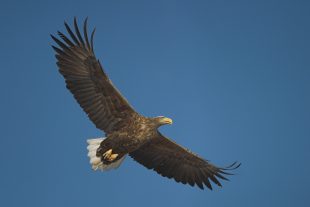Natural England has licensed the re-introduction in Norfolk of white-tailed eagles – one of England’s lost native species. Dave Slater, Director for wildlife licensing cases, explains the decision and how it came to pass. White-tailed eagles were once widespread throughout Britain but persecution in the 19th century drove them to extinction as a breeding population.
Now, the Roy Dennis Wildlife Foundation is working to re-introduce this majestic species – the UK’s largest bird of prey. In 2019, Natural England, as the statutory licensing authority for the re-introduction of species in England, licensed a re-introduction on the Isle of Wight. The project aimed to establish a breeding population along the south coast.
Norfolk re-introduction
This year, the Roy Dennis Wildlife Foundation has drawn up plans to return white-tailed eagles to the east of England at Norfolk’s Wild Ken Hill. And Natural England have issued a licence allowing them to release up to sixty eagles from Poland, as part of a ten-year project.
But the introduction of a new species to the environment, even one that was once native, needs to be carefully managed. Our licensing process makes sure that’s the case.

Safeguarding nature
The landscape today is very different to when white-tailed eagles were last breeding and feeding here. How might that landscape respond to a new resident? What modern ways of life could be impacted? And how might the eagles themselves take to their new home? These and many more questions, covering environmental, social and economic factors, are what we consider when deciding whether to grant a wildlife licence.
It’s an entirely evidence-based, impartial process, in which we assess everything that could make the difference between success and failure, and make sure measures are in place to safeguard local wildlife, as well as anything that may impact on local stakeholders.
For example, we looked at:
- The surrounding area to ensure the habitat was suitable and that there would be sufficient food and nesting places to support a viable breeding population.
- The applicant’s consultation exercise, which has shown that the project has widespread public support.
- The understandable anxiety that the predator will prey on livestock and affect local businesses. We examined evidence from elsewhere in Europe and found no indication that this was likely to be the case. The eagles prefer to hunt around the coast or near water and will predominantly feed on fish, birds and rabbits.
- The potential effect on other wildlife or protected wildlife sites, for which we found it unlikely there would be any serious negative consequences.
Preparing for the unexpected
Of course, it’s not possible to completely rule out impacts on livestock and other wildlife – nature is often unpredictable. But the potential for this has been considered:
- The licence has been extended to 10 years, ensuring a decade-long term of support. That’s well into the period when the eagles are expected to begin breeding.
- An exit strategy has been developed, which could be implemented in the event of unacceptable unforeseen impacts on the local environment or businesses.
- The project will work closely with local landowners to address concerns and look for solutions to resolve any problems that might arise.
If you would like to find out more, you can get a copies of the applicant’s feasibility study, the licence, our licence assessment, and Habitats Regulations Assessment by contacting FOI@naturalengland.org.uk.